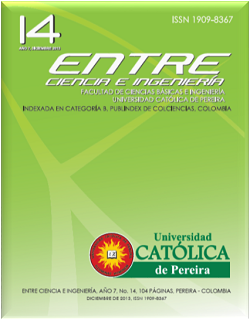Applying the smoothing Spline when modeling the average monthly temperature of Valle del Cauca using weighted Voronoi diagrams
Keywords:
non parametric regression, Spline smoothing, Voronoi diagrams, temperatureAbstract
Understanding some weather phenomena behavior, especially temperature, is very important to many human activities. For this reason the aim of this work is to model monthly temperature in Valle del Cauca between 1971 and 2002 using Weighted Smoothing Splines. Two stratums (valley and mountain), in terms of temperature were considered during the process, since Valle del Cauca is a region located in different thermal floors, that affect its behavior. A voronoi diagram was used to determine the area of influence of each weather station located in the department and assign its modeling weight.
References
Segunda comunicación nacional ante la convención marco de las naciones unidas sobre cambio climático. SCN. 2010.
Eslava, J. “Climatología del Pacífico colombiano”, Academia colombiana de ciencias geofísicas. Bogotá. Colección Eratóstenes, 1994.
Andrade, M. “Monthly Average Temperature Modelling for Valle del Cauca(Colombia)”. Ph.D. dissertation, The University of Reading, 2009.
Boots, B., Okabe, A., Sugihara, K., and Chiu, S.N. “Spatial tessellations: concepts and applications of Voronoi diagrams”. West Sussex, England. Wiley, 2000.
Olaya, “J. Suavización y regresión no paramétrica: una alternativa de modelación estadística”. XV Simposio de Estadistica. Universidad Nacional de Bogotá.
Eubank, R. “Nonparametric Regression and Spline Smoothing”. New York. Marcel Dekker, 1999.
Härdle, W. “Smoothing Techniques With Implementation in S”. New York. Springer-Verlag, 1991.
Bowman, W. and Azzalini, A. “Applied smoothing techniques for data analysis: the kernel approach with S-Plus illustrations”. New York. Oxford University Press, 1997.
Hastie, T. and Tibshirani, R. “Generalized Additive Models”. Chapman & Hall, London (1990)
Rice, J. “Bandwidth Choice for Nonparametric Regression”. The Annals of Statistics, vol. 12, no. 4, pp. 1215-1230. 1984.
Gasser, T., Sroka, L. and Jennen-Steinmetz, C. “Residual Variance and Residual Pattern in Nonlinear Regression”. Biometrika, vol. 73, no. 3, pp. 625-633. 1986
Hall, P., Kay, J. W. and Titterington, D. M. “Asymptotically Optimal Difference-Based Estimation of Variance in Nonparametric Regression”. Biometrika, vol. 77, no.3, pp. 521-528. 1990
Dette, H., Munk, A. and Wagner, T. “Estimating the Variance in Nonparametric Regression-What is a Reasonable Choice?” 4, Journal of the Royal Statistical Society. Series B (Statistical Methodology), vol. 60, no. 4, pp. 751-764. 1998.
Florez, A. y Olaya, J. “Estudio de simulación para comparar varios estimadores de varianza en el marco de la regresión no paramétrica”. Comunicaciones en Estadística, vol. 7, n 1, pp 49-66. 2014
Andrade, M. y Longford, N. “Outliers in mixed models for monthly average temperatures”. Austrian Journal of Statistics, vol. 39, n. 3, pp. 203-221. 201








 Revista Entre Ciencia e Ingeniería
Revista Entre Ciencia e Ingeniería .png) entrecei@ucp.edu.co
entrecei@ucp.edu.co.png) ISSN (Impreso) 1909-8367 - ISSN (En Línea) 2539-4169
ISSN (Impreso) 1909-8367 - ISSN (En Línea) 2539-4169 Attribution-NonCommercial 4.0 International (CC By-NC 4.0)
Attribution-NonCommercial 4.0 International (CC By-NC 4.0)
.png) Carrera 21 No. 49-95 Av. de las Américas, Pereira, Risaralda, Colombia
Carrera 21 No. 49-95 Av. de las Américas, Pereira, Risaralda, Colombia